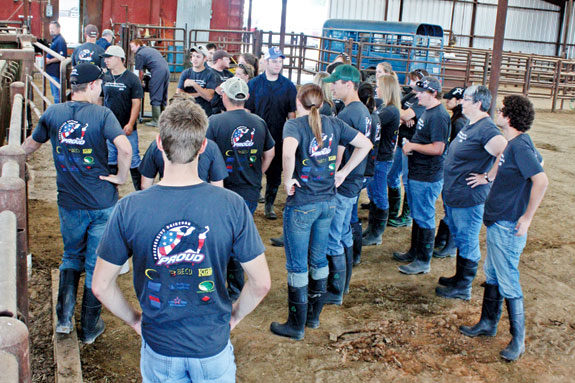During recent years, many universities in the Southwest started closing their dairy herds, a fact that sparked a definite need for a program focused on educating students interested in pursuing careers in advanced large-herd dairy management. The Southern Great Plains Dairy Consortium (SGPDC), based out of Texas A&M University in College Station, Texas, and hosted by Clovis Community College in Clovis, New Mexico, was designed with that mission. The program has rapidly grown in student participation since its inception in the summer of 2008.
“At first we were envisioning a two-year program,” says Michael Tomaszewski, one of the program’s coordinators. “The first year the program was held on a trial-and-error basis; the program was modified the second year to include more courses and target other industry areas.”
This summer, however, the consortium experienced growth in student numbers not seen in previous years. The program had 18 students the first year and 22 the second year. The program had 36 students this year, some of whom were returning students from previous years. A second section was added to accommodate returning students, who were classified as “advanced” and were taught at a higher level than first-year participants.
Tomaszewski, a professor at Texas A&M University since 1975 and one of the program coordinators, observed how teaching opportunities disappeared when university dairy programs first began to close – and decided to take action. He along with faculty members from other Southwestern universities brainstormed and developed an initial program outline. Tomaszewski defines the program as a “must” for students planning on entering careers in the dairy industry in the Southwest.
 “Last year I learned basic nutrition, reproduction and heifer management,” says Shay McDonald, one of the program’s returning students from Texas A&M University. “This year, we learned about human resources and management of large herds. I have been able to get this experience, which will ‘give me a leg up’ when I apply for veterinary school in the fall.”
“Last year I learned basic nutrition, reproduction and heifer management,” says Shay McDonald, one of the program’s returning students from Texas A&M University. “This year, we learned about human resources and management of large herds. I have been able to get this experience, which will ‘give me a leg up’ when I apply for veterinary school in the fall.”
This year’s program ran from May 17 to June 25. Session I was designed for students attending the program for the first time. Session II was for those students taking advanced courses in large-herd management. Of the 36 students this year, five students returned for the advanced section and four other students were placed in Session II because they were already veterinary students or had completed their undergraduate degrees.
Students interested in participating in the consortium are required to submit an application as well as a letter of intent, both of which are reviewed by program coordinators. The students are selected based on specific criteria, including their interest in a career in large-herd dairy management. Other criteria include faculty recommendations and academic records. Scholarships for the program are also available to students from participating universities to cover tuition for the six-week program. Company grants have funded the program every year, lowering the cost students pay in the end.
“Basically, for me, most of the program was paid for,” says McDonald. “I have to pay some tuition over the summer, but I did receive a scholarship from my university, which helped pay for a lot of the tuition.”

Based on the positive feedback from participating students and the increase in student enrollment, the consortium envisions accomplishing one main goal in upcoming years.
“Out of necessity, we developed the program,” says Tomaszewski. “Now, we would like for the program to become a center of excellence for large-herd management in the U.S., so that anyone who wants to learn about large-herd management will come here and become a part of the program.” PD
Check out more photos from the program in Dario's June 29 article.
PHOTOS
TOP RIGHT: First-year students gathered at Southern Draw Dairy for a lab section on bull fertility.
TOP LEFT: Students obtained hands-on experience throughout reproduction week, including dissecting reproductive tracts and sexing fetuses.
BOTTOM RIGHT: Ultrasound systems were set up at a dairy near Plainview, Texas, for students to learn how to use different ultrasound equipment to observe fetal development. Photos by Dario Martinez.




